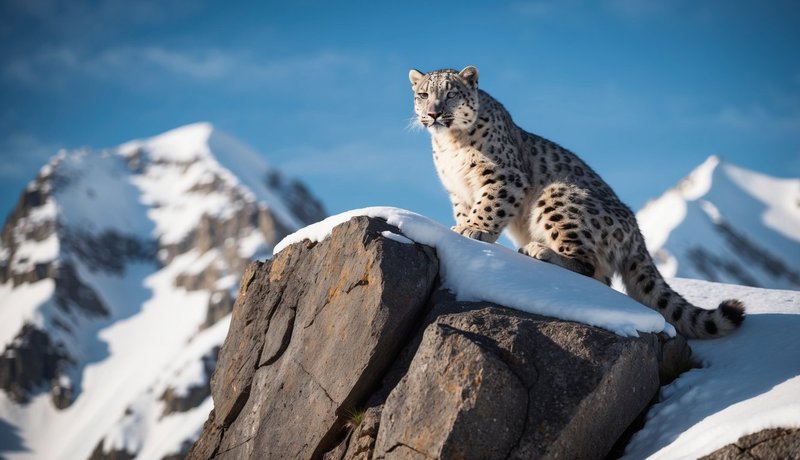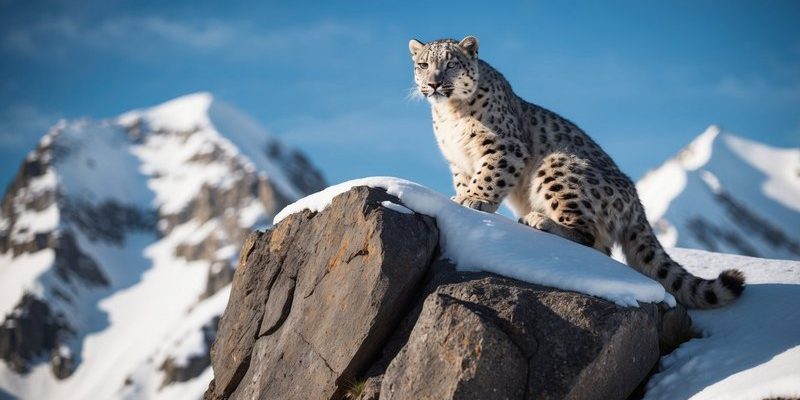
Snow leopards inhabit mountainous regions of Central and South Asia, including the Himalayas and the Tibetan Plateau. These magnificent creatures have evolved over thousands of years, developing unique traits that allow them to survive in environments that would be harsh for most other animals. Honestly, it’s fascinating to see how nature equips these cats to tackle adversity head-on.
The Snow Leopard’s Physical Adaptations
Snow leopards are equipped with a series of remarkable physical features that help them conquer their rugged surroundings. First off, their thick, luxurious fur isn’t just for show. It provides essential insulation against freezing temperatures. You might say it’s like wearing a built-in winter coat! The color pattern of their fur, which is a mix of smoky gray with black rosettes and spots, helps them blend seamlessly into the rocky landscapes, allowing for stealth while hunting.
Another key feature is their large, padded paws, which work like snowshoes, distributing their weight across the snow. This adaptation prevents them from sinking too deeply, making it easier to move around and stalk prey. Can you imagine trying to navigate through heavy snow without that advantage? Plus, their long tails are not just for balance; they also help with maintaining body heat when wrapped around their bodies.
Hunting in the High Mountains
Let’s talk about food—an essential topic for any predator. Snow leopards primarily hunt wild sheep and goats, like the blue sheep and ibex. They have keen eyesight and can spot prey from great distances. When the opportunity arises, they rely on their powerful hind legs to leap across steep cliffs and rocky outcrops, sometimes covering distances of up to 30 feet in a single bound. That’s quite a feat!
But here’s the kicker: snow leopards often need to be patient. Given the sparse population of prey animals in harsh climates, they might go days without a meal. Their ability to fast for long periods is crucial. This means they must make every hunt count, relying on strategy and stealth rather than just brute force. Imagine being hungry for a while, then finally spotting your next meal in the distance—it’s all about the thrill of the chase.
Water Conservation Strategies
Snow leopards have unique ways to manage water intake, a vital aspect of survival in dry, extreme environments. Surprisingly, they don’t rely heavily on drinking water. Instead, they get most of their hydration from the food they consume, like the flesh of their prey. It’s like having a built-in hydration system!
Additionally, their kidneys are incredibly efficient at retaining water, allowing them to survive with minimal liquid intake. This adaptation is a beautiful example of how these cats have evolved to face the challenges of their habitat. You might wonder how many other animals could thrive with such a clever strategy!
Staying Warm in Freezing Conditions
Surviving frigid temperatures is no small feat, and snow leopards have mastered the art of keeping cozy. Besides their thick fur, they have a layer of fat beneath their skin that offers additional insulation. That’s right—these leopards are literally built to withstand the cold.
The shape of their bodies also plays a role. Their stocky build helps conserve body heat, while their small ears reduce heat loss. It’s all about efficiency! You might think of these adaptations as nature’s way of designing the ultimate cold-weather survival kit.
Social Behavior and Territory
Snow leopards are generally solitary animals, which is an interesting strategy in a harsh landscape. Their large territories can span up to 100 square miles, allowing them to cover ground in search of food without competing too closely with others. When it comes to mating, these big cats do come together, but beyond that, they prefer to enjoy their own company.
Territorial marking is crucial, too. Snow leopards use scent markings—like urine and scrapes on the ground—to communicate with other leopards. This behavior helps them indicate their territory and find mates without direct confrontation. It’s all part of their survival strategy in a world where resources are limited.
Conservation Challenges
Despite their impressive adaptations, snow leopards face significant threats. Habitat loss due to human encroachment and climate change are two major factors. As the planet warms, the high-altitude areas they call home are becoming less stable, leading to shrinking ranges and fewer resources. You might be wondering, how do we help them?
Conservation efforts are essential. Organizations are focusing on protecting their habitats and promoting coexistence strategies with local communities. Raising awareness about these incredible animals can also play a big role in ensuring their survival. Every small action counts in the fight to keep these majestic creatures thriving.
The Importance of Snow Leopards in Their Ecosystem
Snow leopards aren’t just beautiful; they play a critical role in their ecosystem. As apex predators, they help maintain the balance of animal populations in their habitats. By hunting herbivores like ibex, they help prevent overgrazing, which can lead to habitat degradation.
Their presence signifies a healthy ecosystem. When snow leopards thrive, it often means that other species in the food chain are also doing well. You might think of them as the caretakers of their environment, ensuring that nature runs smoothly.
In conclusion, snow leopards are truly remarkable creatures that embody resilience and adaptability. Their skills and physical traits have crafted a life perfectly suited to one of the harshest environments on Earth. As we learn more about them, it’s crucial to support conservation efforts to protect these majestic animals for future generations. After all, every species has a role to play in the grand tapestry of nature, and snow leopards deserve a place in it.

